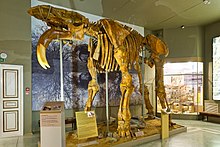
Back دينوثيريوم Arabic داينوثيريوم ARZ Динотерии Bulgarian Dinoteri Catalan Deinotherium Czech Deinotherium German Dinoterio Esperanto Deinotherium Spanish Deinotherium Basque سهمگیندد Persian
| Deinotherium Temporal range:
| |
|---|---|

| |
| D. giganteum skeleton cast from the Azov Museum of History, Archaeology and Paleontology | |
| Scientific classification | |
| Domain: | Eukaryota |
| Kingdom: | Animalia |
| Phylum: | Chordata |
| Class: | Mammalia |
| Order: | Proboscidea |
| Family: | †Deinotheriidae |
| Subfamily: | †Deinotheriinae |
| Genus: | †Deinotherium Kaup, 1829 |
| Type species | |
| †Deinotherium giganteum Kaup, 1829
| |
| Species | |
Deinotherium is an extinct genus of large, elephant-like proboscideans that lived from about the middle-Miocene until the early Pleistocene. Although its appearance is reminiscent of modern elephants, Deinotherium possessed a notably more flexible neck, with limbs adapted to a more cursorial lifestyle, as well as tusks which grew down and curved back from the lower jaw, as opposed to the upper mandible tusks seen in extant elephants. Deinotherium was a widespread genus, ranging from East Africa, north to southern Europe, and east to the Indian subcontinent. They were primarily browsing animals, with a diet largely consisting of leaves. The genus most likely went extinct due to environmental changes, such as forested areas gradually being replaced by open grasslands, during the latter half of the Neogene. Deinotherium thrived the longest in Africa, where they were found into the early Pleistocene.
© MMXXIII Rich X Search. We shall prevail. All rights reserved. Rich X Search